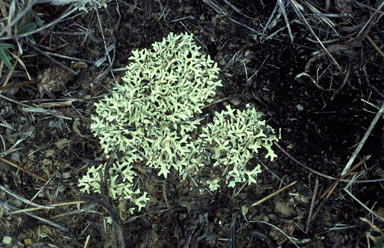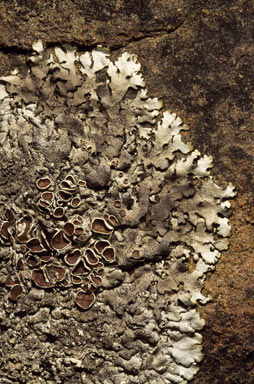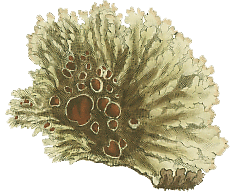
Xanthoparmelia
Why devote a page to just the one genus Xanthoparmelia? It is widespread in Australia, with the most species of any lichen genus found in this country and has been well studied (both in Australia and overseas) so that much is known about the Xanthoparmelia species in Australia and their relationships with those from other parts of the world. That's not to say that there is nothing else to be learnt. Each year sees the discovery of new species or of the discovery of already known species in new areas, sometimes distant from where the species had previously been known. The genus is found on all continents except Antarctica and is the largest genus of foliose lichens in the world, with about 750 species known. The greatest diversity of species is found in southern Africa and Australia, each with approximately 300 species and each with a high percentage of endemic species. South America and North America each appear to have no more than about 100 species each while each of Europe, Asia, North Africa and the Middle East have fewer species than either North or South America. The genus is especially abundant in the drier areas and the Australian lichenologist Jack Elix, who has studied the genus for several decades, has commented:
Indeed the genus Xanthoparmelia is probably the most dominant group of foliose rock-inhabiting lichens in hot semi-arid climates of the world
.
However, within Australia, you don't need to visit the inland in order to see species of the genus. It is likely that many readers of this page will have seen one or more species of Xanthoparmelia, even during mundane activities such as travelling to or from work, going shopping or mustering livestock and you'll see why in the 'What do they grow on?' section a little later. In the final section of this page you will see that Xanthoparmelia is a good source of examples to illustrate the subject of BIOGEOGRAPHY. Elsewhere a discussion of XANTHOPARMELIA TAXONOMY gives concrete examples of some general comments on the CLASSIFICATION page.
What do they look like?
The thalli are foliose though there are species with thalli so tightly attached to their substrates as to appear almost crustose ![]() . In some species the individual thalli are fairly small, no more than a centimetre or two in diameter, in a great many they are from several centimetres to about 10 centimetres in diameter and there are species where thallus diameters may exceed 10 centimetres. Even many species with small thalli are often noticeable from a distance. The thalli commonly grow in large colonies, with the separate thalli at times growing in contact with each other.
. In some species the individual thalli are fairly small, no more than a centimetre or two in diameter, in a great many they are from several centimetres to about 10 centimetres in diameter and there are species where thallus diameters may exceed 10 centimetres. Even many species with small thalli are often noticeable from a distance. The thalli commonly grow in large colonies, with the separate thalli at times growing in contact with each other.
The thalli of almost all Xanthoparmelia species are attached to their substrates and Xanthoparmelia semiviridis is one of the very rare exceptions. Its thalli are loose and able to be blown about, especially when dry and curled up ![]() . With moisture they uncurl and flatten
. With moisture they uncurl and flatten ![]() . This species is an example of a VAGRANT LICHEN.
. This species is an example of a VAGRANT LICHEN.
Xanthoparmelia thalli are very commonly yellow green (and part of the genus name is derived from the classical Greek word 'xanthos' meaning yellow) but there are many species with thalli that are olive green, greyish green, grey or brown ![]() . The thalli of various species darken with age so that while the areas towards the margins might, for example, be yellow green, the central area could be greyish green to blackish green
. The thalli of various species darken with age so that while the areas towards the margins might, for example, be yellow green, the central area could be greyish green to blackish green ![]() . The thalli are composed of lobes that grow radially and branch. In some species the individual lobes may be no wider than a millimetre or so whereas others have lobes that may be almost a centimetre wide when hydrated but which may curl inwards along their long axes to be no more than 4 or 5 millimetres wide when dry.
Xanthoparmelia pseudoamphixantha
. The thalli are composed of lobes that grow radially and branch. In some species the individual lobes may be no wider than a millimetre or so whereas others have lobes that may be almost a centimetre wide when hydrated but which may curl inwards along their long axes to be no more than 4 or 5 millimetres wide when dry.
Xanthoparmelia pseudoamphixantha ![]() and Xanthoparmelia substrigosa
and Xanthoparmelia substrigosa ![]() show some of the variation in the shapes of thallus lobes. The lobes may grow in a fairly open fashion so that the individual lobes are easy to see, as in Xanthoparmelia reptans, but at the other extreme are species where the lobes are very densely packed. When sexual spores are produced they are produced in apothecia which are very common in some species but rare in others and there are species for which apothecia have never been seen. There are species with isidia or soredia (means of VEGETATIVE REPRODUCTION) and species without either. Isidia vary from simple finger-like projections to the antler-like isidia of Xanthoparmelia antleriformis. Xanthoparmelia ewersii has an isidia-free margin but the isidia are dense inward in the darker coloured areas shown in this photograph
show some of the variation in the shapes of thallus lobes. The lobes may grow in a fairly open fashion so that the individual lobes are easy to see, as in Xanthoparmelia reptans, but at the other extreme are species where the lobes are very densely packed. When sexual spores are produced they are produced in apothecia which are very common in some species but rare in others and there are species for which apothecia have never been seen. There are species with isidia or soredia (means of VEGETATIVE REPRODUCTION) and species without either. Isidia vary from simple finger-like projections to the antler-like isidia of Xanthoparmelia antleriformis. Xanthoparmelia ewersii has an isidia-free margin but the isidia are dense inward in the darker coloured areas shown in this photograph ![]() . Xanthoparmelia reptans and Xanthoparmelia lithophiloides, shown above, lack both isidia and soredia.
. Xanthoparmelia reptans and Xanthoparmelia lithophiloides, shown above, lack both isidia and soredia.
What do they grow on?
Earlier I noted that Xanthoparmelias are common on rock and it is on rock that you will find them most often. This photo ![]() shows numerous Xanthoparmelia colonies on sub-alpine boulders in Kosciusko National Park, New South Wales and on this hillside
shows numerous Xanthoparmelia colonies on sub-alpine boulders in Kosciusko National Park, New South Wales and on this hillside ![]() in Molonglo Gorge, near Canberra, almost every rock surface is covered with Xanthoparmelia thalli. Xanthoparmelias can be found on a variety of volcanic, sedimentary or metamorphic rocks but very rarely on limestone. Xanthoparmelia neodelisea, endemic to Australia, has been found only on calcareous rocks. Many species can also be found on soil (though more rarely on calcareous soils) sometimes also overgrowing the fine debris that can accumulate on the ground. The photograph of Xanthoparmelia reptans earlier on this page was taken alongside a sports oval in the Canberra suburb of Kaleeen and the lichen was growing on a patch of bare soil in a patchily grassed area. There were just a few thalli present but sometimes you will see numerous thalli on soil, as shown by this photograph
in Molonglo Gorge, near Canberra, almost every rock surface is covered with Xanthoparmelia thalli. Xanthoparmelias can be found on a variety of volcanic, sedimentary or metamorphic rocks but very rarely on limestone. Xanthoparmelia neodelisea, endemic to Australia, has been found only on calcareous rocks. Many species can also be found on soil (though more rarely on calcareous soils) sometimes also overgrowing the fine debris that can accumulate on the ground. The photograph of Xanthoparmelia reptans earlier on this page was taken alongside a sports oval in the Canberra suburb of Kaleeen and the lichen was growing on a patch of bare soil in a patchily grassed area. There were just a few thalli present but sometimes you will see numerous thalli on soil, as shown by this photograph ![]() taken in dry country at Calperum, near Renmark in South Australia. A few species of Xanthoparmelia are found on wood, but very rarely.
taken in dry country at Calperum, near Renmark in South Australia. A few species of Xanthoparmelia are found on wood, but very rarely.
Boulders in paddocks are a very common substrate for Xanthoparmelias and species of this genus may be found on boulders large or small or even pebbles. In many parts of Australia boulders of volcanic rock are common on grazing properties, so if you run such property it's very likely you have seen Xanthoparmelias while mustering stock or checking fences. In urban areas you can find Xanthoparmelia growing on bitumen, as shown by this photo ![]() of part of a Canberra road. The individual thalli are no more then a few centimetres in diameter. Xanthoparmelia, though not abundant on bitumen in Canberra, is by no means rare and you will sometimes find quite large colonies - especially in less-trafficked areas. Bricks are similar to rocks so you can find some species on brick or rock walls (though tending to avoid the calcareous mortar).
of part of a Canberra road. The individual thalli are no more then a few centimetres in diameter. Xanthoparmelia, though not abundant on bitumen in Canberra, is by no means rare and you will sometimes find quite large colonies - especially in less-trafficked areas. Bricks are similar to rocks so you can find some species on brick or rock walls (though tending to avoid the calcareous mortar).
This glass bottle ![]() shows a good coverage by Xanthoparmelia mougeotina and various parts of this long-abandoned Western Australian school bus
shows a good coverage by Xanthoparmelia mougeotina and various parts of this long-abandoned Western Australian school bus ![]() have Xanthoparmelia colonies. Xanthoparmelia is the dominant lichen genus on this well-rusted metal
have Xanthoparmelia colonies. Xanthoparmelia is the dominant lichen genus on this well-rusted metal ![]() in central New South Wales and here
in central New South Wales and here ![]() is a closer view. Also in central New South Wales, this leather shoe
is a closer view. Also in central New South Wales, this leather shoe ![]() had been discarded long ago alongside a road near Eugowra and this old kettle
had been discarded long ago alongside a road near Eugowra and this old kettle ![]() was found in a rubbish tip near Parkes. Here
was found in a rubbish tip near Parkes. Here ![]() is a small Xanthoparmelia thallus that has developed in my back yard on a section of artificial shade cloth (sold under the trademark name Sarlon).
is a small Xanthoparmelia thallus that has developed in my back yard on a section of artificial shade cloth (sold under the trademark name Sarlon).
While many species are found only on rock at the other extreme is Xanthoparmelia scabrosa, one of the most common species in Australia, which tolerates a wide variety of substrates. It is found predominantly on rock but has been found on tree bark, decorticated wood, slate, roofing tiles (of non-concrete types since concrete is calcareous), glass and in wetter areas it is common on bitumen.
A note about Flavoparmelia rutidota
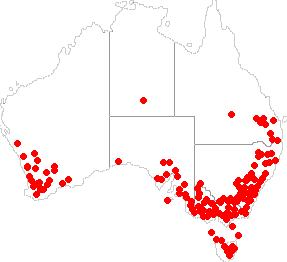 While shades of yellow-green are the commonest colours for Xanthoparmelia, not all lichens with yellow green to greenish foliose thalli belong to the genus Xanthoparmelia. Correct identification of Xanthoparmelia requires the observation of a number of features and you can find some identification guides listed in the FURTHER INFORMATION page. Though there are a number of species that are somewhat ' Xanthoparmelia-like', it is worth drawing attention particularly to Flavoparmelia rutidota
While shades of yellow-green are the commonest colours for Xanthoparmelia, not all lichens with yellow green to greenish foliose thalli belong to the genus Xanthoparmelia. Correct identification of Xanthoparmelia requires the observation of a number of features and you can find some identification guides listed in the FURTHER INFORMATION page. Though there are a number of species that are somewhat ' Xanthoparmelia-like', it is worth drawing attention particularly to Flavoparmelia rutidota ![]() , simply because it is a species many people will have seen. It is very common on living trees or dead wood in many parts of the southern half of Australia and has been described as "probably the commonest lichen found on dead wood in Australia". The map on the right shows where it has been found. As you can see it occurs in or near most cities or major towns of Australia. In Canberra it is very common on both native and introduced tree species and many Canberrans would have good sized thalli of Flavoparmelia rutidota growing on their well-established fruit trees, with no detriment to the production of fruit. Flavoparmelia rutidota has been found growing on rock, but rarely. Remember that Xanthoparmelia species are mostly on rock and rarely on wood
, simply because it is a species many people will have seen. It is very common on living trees or dead wood in many parts of the southern half of Australia and has been described as "probably the commonest lichen found on dead wood in Australia". The map on the right shows where it has been found. As you can see it occurs in or near most cities or major towns of Australia. In Canberra it is very common on both native and introduced tree species and many Canberrans would have good sized thalli of Flavoparmelia rutidota growing on their well-established fruit trees, with no detriment to the production of fruit. Flavoparmelia rutidota has been found growing on rock, but rarely. Remember that Xanthoparmelia species are mostly on rock and rarely on wood![]() .
.
Where can you find Xanthoparmelias?
At the start of this page I noted that Xanthoparmelia is widespread in Australia. In the next section there will be a more detailed discussion of biogeography but for the moment I'll look at the genus as a whole, in Australia, and compare it with a couple of other genera.
The leftmost map of the following trio gives you an idea of where you can find Xanthoparmelia. It is based largely on the distribution maps published in volume 55 of the Flora of Australia which gave descriptions and distributions of the 213 species then known to be in Australia. That volume was published in 1994 and since then many more Xanthoparmelia species have been reported for Australia and many more collections of already known species have been lodged in Australian herbaria. Therefore I have added the distributional information from several later publications and also information gleaned from later specimens in the Australian National Herbarium (in Canberra) that have been reliably identified as Xanthoparmelia. Additional specimens have been lodged in other herbaria and some very basic information about many of these is available online. However, I have erred on the side of caution and have excluded other herbaria as I wished always to be able to check the actual specimens and who identified them, in case of any seemingly odd localities. Hence the Xanthoparmelia map is likely to under-represent the areas where Xanthoparmelia has been found but it is clear that the genus is widespread, though the greater number of species are found in the southern half of Australia.

For comparative purposes I have presented the Australian distributional information for two other large genera. The middle map shows the information for Lecanora (with about 600 species worldwide of which about 90 are known to occur in Australia) and the rightmost map features Pertusaria (with about 500 species worldwide and about 150 in Australia, making it the country's second largest lichen genus). Detailed discussions of both appeared in 2004 in volume 56A of the Flora of Australia series and the starting point for each of the Lecanora and Pertusaria maps is the information in that volume and that accounts for most of the map dots. I have added the information from all the additional Australian herbarium specimens that have their basic details available online. This may include some incorrectly identified specimens so that the Lecanora and Pertusaria maps may over-represent the areas where those two genera have been found. Both genera fall well behind Xanthoparmelia in numbers of known species but Lecanora approaches Xanthoparmelia in the area of Australia in which species of the genus are found. It is important to remember that these maps are based on herbarium specimens and so show places where specimens have been collected. There are places not yet visited by lichen collectors and that would account for parts of the white areas. From the Xanthoparmelia and Lecanora maps it is clear that there has been much specimen collecting in various parts of inland Australia. This helps show that the paucity of Pertusaria records from inland areas is not caused by lack of specimen collecting in those areas, but has more to do with the ecological preferences of that genus. Currently most Pertusaria species are found in areas with an annual rainfall of more than about 500 millimetres. There are a few other genera with Australian distributions much like that of Lecanora. A good example is Caloplaca, often with bright orange, crustose thalli ![]() and with about 120 species in Australia, probably making it the country's third largest lichen genus
and with about 120 species in Australia, probably making it the country's third largest lichen genus![]() .
.
Biogeography
According to the online Australian lichen checklist maintained by the Australian Biological Resources Study, by January 2010 there were 307 species of Xanthoparmelia recorded for Australia or its island territories. The checklist records in which Australian states or territories a given species has been found and also notes if a species is known from outside Australia. The checklist of such magnitude is bound to have some errors or omissions from time to time but these are likely to be minor. The analysis below is based on the checklist counts, with minor corrections based on information from other sources. It is almost inevitable that the numbers below (though given seemingly with precision) will still contain some errors, but they should be a good approximation to the truth and so support the broad conclusions given below.
Of those 307 Xanthoparmelia species, about 200 were known only from the Australian mainland or Tasmania, two were known from just Lord Howe Island as well as the Australian mainland, another was known only from Lord Howe Island and the remainder had been found in a variety of other countries. On the basis of these figures about two thirds of the Xanthoparmelia species found in Australia could be considered endemic, compared to an endemism rate of about one third for all the lichens found in Australia. Even allowing for the uncertainties in the numbers it is clear that Xanthoparmelia shows a higher level of endemism in Australia than do lichens in general. There is also a high level of endemism in the Xanthoparmelias of southern Africa, indicating that there has been considerable evolution of the genus in those two areas. Australia and southern Africa have perhaps between 40 and 50 species in common, some of which were also found in other parts of the world. Australia also shares a significant number of species with New Zealand. Of the 68 species found in Australia and New Zealand (and possibly elsewhere as well) 38 were found in only New Zealand and one or both of the Australian mainland and Tasmania. Incidentally, only 11 of New Zealand's 81 Xanthoparmelia species are endemic. Australia shares about 20 species with South America, not all of those exclusive to Australia and South America![]() .
.
The starting point for information about species numbers from other areas has been this website of lichen checklists: http://www.checklists.de/. There are occasional discrepancies between the claims in these checklists and other web or printed sources that I consulted, hence the need for a little caution with the numbers given above.
Though the first map in the previous section showed the genus to be found in a large part of Australia, the 307 species show a wide variety of distributions. Some are very widespread while others are thus far known from very limited areas. The rest of this section is given over to examples of various distributions. If a species has been found outside mainland Australia and Tasmania I'll note where else it has been found.
Let's start with a few species that are widely distributed in Australia. The leftmost of the following trio of maps shows distributional details for Xanthoparmelia amplexula ![]() (red dots - and the species is also found on Lord Howe Island, New Caledonia, both islands of New Zealand and South Africa) and Xanthoparmelia isidiigera (blue dots - Papua New Guinea, New Caledonia, both islands of New Zealand and Mexico). The central map features Xanthoparmelia praegnans
(red dots - and the species is also found on Lord Howe Island, New Caledonia, both islands of New Zealand and South Africa) and Xanthoparmelia isidiigera (blue dots - Papua New Guinea, New Caledonia, both islands of New Zealand and Mexico). The central map features Xanthoparmelia praegnans ![]() (red dots) and Xanthoparmelia versicolor (blue dots) and on the right hand map are the details for Xanthoparmelia bungendorensis (red dots) and Xanthoparmelia remanens (blue dots - southern Africa).
(red dots) and Xanthoparmelia versicolor (blue dots) and on the right hand map are the details for Xanthoparmelia bungendorensis (red dots) and Xanthoparmelia remanens (blue dots - southern Africa).

Of the next pair the left hand map shows Xanthoparmelia tasmanica (red dots - Lord Howe Island, both islands of New Zealand, North America, Central America, Kenya and South Africa) and Xanthoparmelia mougeotina (blue dots - both islands of New Zealand, Thailand and Brazil). The right hand map shows Xanthoparmelia reptans (red dots - south island of New Zealand), Xanthoparmelia taractica ![]() (blue dots - south island of New Zealand and from Argentina to Columbia in South America) and Xanthoparmelia tegeta (black dots - south island of New Zealand and South Africa). These five species are conspicuous by their absence from central Australia and largely show an east-west disjunct distribution, though Xanthoparmelia mougeotina does also turn up in the north west. There are many species which, like the two of the right hand map, are found predominantly or only in Australia's southern half.
(blue dots - south island of New Zealand and from Argentina to Columbia in South America) and Xanthoparmelia tegeta (black dots - south island of New Zealand and South Africa). These five species are conspicuous by their absence from central Australia and largely show an east-west disjunct distribution, though Xanthoparmelia mougeotina does also turn up in the north west. There are many species which, like the two of the right hand map, are found predominantly or only in Australia's southern half.
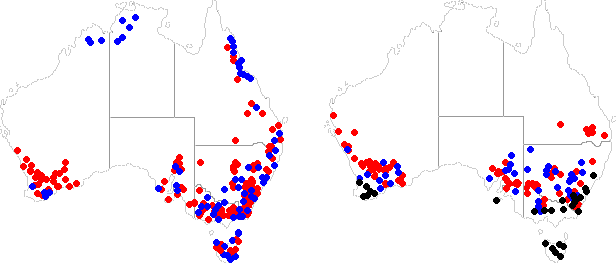
The species so far mapped are widely distributed over large areas. There are also species that, though still found over large areas in Australia, are confined to markedly smaller regions than the previous species. The leftmost map in the next series shows Xanthoparmelia colensoides (red circles), Xanthoparmelia convoluta (red dots), Xanthoparmelia elevata (black dots), Xanthoparmelia pseudoamphixantha (blue dots) and Xanthoparmelia trirosea (black circles). The middle map shows the known distributions of Xanthoparmelia adusta (blue dots), Xanthoparmelia leppii (black dots) and Xanthoparmelia thamnoides (red dots - both islands of New Zealand). The rightmost map features Xanthoparmelia juxtata (red dots) and Xanthoparmelia rubrireagens (black dots - south island of New Zealand).
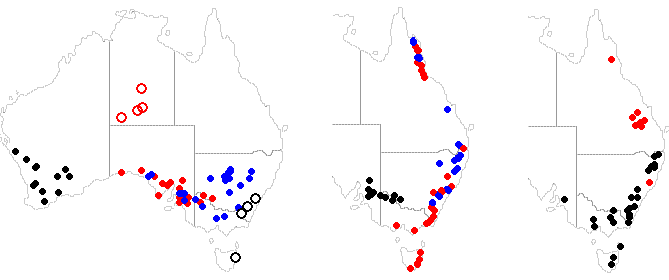
Xanthoparmelia adusta, Xanthoparmelia juxtata, Xanthoparmelia rubrireagens and Xanthoparmelia thamnoides are examples of species essentially with a distribution along the Great Dividing Range (which parallels the east Australian coast) or the narrow band between that range and the sea, though the distribution of Xanthoparmelia rubrireagens extends to South Australia and that of Xanthoparmelia thamnoides to Tasmania. The Great Dividing Range offers a great variety of habitats, from tropical to cool-temperate climates. While it's clear that some species can tolerate a wide range of conditions along the range (and Xanthoparmelia thamnoides is a good example), others appear unable to do so. Current knowledge suggests that Xanthoparmelia juxtata prefers the northern half of that area. There is a concentration of sites in southern Queensland where that species has been found but you can see two marked outliers - one in north Queensland and the other in northern New South Wales. This suggests the species may be found in the areas in between the outliers and the central concentration since there should be various areas in between that provide conditions similar to those where the species has already been found.
There are species known from very limited areas of Australia and the left hand map below gives a few examples: Xanthoparmelia applicata (blue cross - South Africa), Xanthoparmelia bicontinens (black squares - South Africa), Xanthoparmelia calida (blue dots), Xanthoparmelia nigraoleosa (blue squares), Xanthoparmelia rogersii (red circle - east Africa), Xanthoparmelia schmidtii (red dots - North America), Xanthoparmelia suberadicata (blue circles - south island of New Zealand, Madagascar, South Africa) and Xanthoparmelia verruciformis (black circle - South Africa).
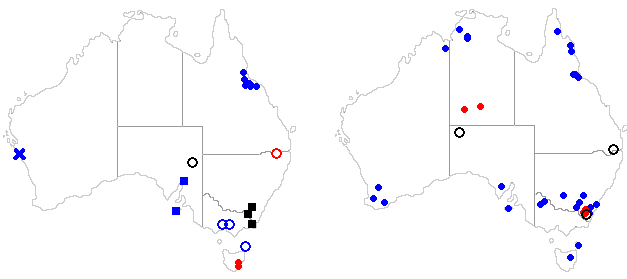
The right hand map of the above pair shows a few oddities or puzzles. Xanthoparmelia congensis (blue dots) shows a disjunct north-south distribution in Australia and is also found in southern Africa and South America. Xanthoparmelia consociata (red dots) is known from the Northern Territory, the Australian Capital Territory and nearby south-east New South Wales and Lord Howe Island. Xanthoparmelia exuviata (back circles) is known from north-west South Australia, south-east Queensland, south-east New South Wales and Lord Howe Island.
For each species that appears in the final pair of maps, the known distribution immediately prompts the question: Where else (in Australia or overseas) does the species occur? For example, surely Xanthoparmelia exuviata must occur elsewhere on the Australian mainland than near the east coast and in central Australia. Current knowledge of the species suggests it should be able to tolerate the conditions in many other areas as well. Yet, if it does grow elsewhere in Australia, how is it that it has not been found elsewhere, given that Xanthoparmelia specimens have been collected widely in this country. On the one hand, the evidence suggests that the species is rare in Australia, but on the other hand the evidence suggests that the species is one that are likely to be found in more locations.
![An Australian Government Initiative [logo]](/images/austgovt_brown_90px.gif)


